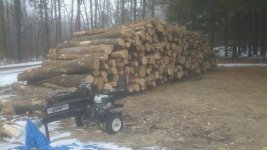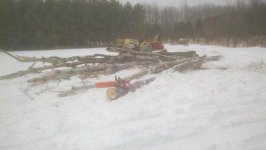Efficient yes im sure. CHEAP i doubt buying your system and installing in can remotely be called cheap. I admit i have not clicked the link but have an idea what it is and what it may run.
I too thought this thread was gonna be a complaint about insurance or about how to obtain it after a burner install.
I have an indoor FP insert. It a cat model stove. I have not used my heatpump this season (although its been a mild winter i know), and install last february saved $100 over the previous year in feb.
Whats the pay off in years for your system vs a similar system thats not as fancy (ie computer controlle). Whats the pay off vs installing a high effeciency wood stove stand alone unit in your home like the eglander 30 or a blazeking king? Yes these are indoors but i wonder if the cheaper cost will allow a quicker rate of return, well im sure it will. After all recooping your investment as fast as possible is what folks intodays tough times are after. They either need to pay the loan off fast or want that money back in the account for other things if needed.
I really am curious, one day id love to have an outdoor wood boiler/heating system. My problem is that i dont have $6k for one right now. Which is why i went with my used $900 stove that i purchased instead. Did i mention i too am cheap?
You could get our larger VaporFire 100 delivered for under $5,000 which isn't cheap for some, but these things our built to last. The fireboxes are under warranty for 25 years. With brick lining to the ceiling and ceramic lining behind the fire brick it is designed for a lifetime. All the internal parts are made with stainless steel and are replaceable.
If your interested in comparison vs many of the stoves one see's at Menard's or Lowe's here's some good info:
What is the impact on total wood consumption per year if you use a super efficient furnace like our VaporFire?
Here are the important numbers that need to be examined: 1 gal. #2 fuel oil = 140,000 BTUs; 1 gal. propane - 91,500 BTU's; 1 cord paper birch wood = 21 M BTU's; 1 cord red oak = 25 M BTU's.
VaporFire furnaces were tested to have an overall efficiency as high as 85%, 99.4% combustion efficiency, less than 1 gr/hr of emissions, 99% smokeless burn cycles, internal flue temperatures 285-400 degrees F., and external flue temperatures 150-250 degrees F. VaporFire furnaces have been used for over 25 years with no condensation issues whatsoever, because the flue temperatures are still high enough to support a natural draft system when installed according to our written directions.
A good estimate for oil usage for a heating season would be 500-1,000 gal., with lots of variables. We'll take a look at an average home using 750 gal. of oil for the heating season. 750 gal = 105 M BTU's. If a wood furnace was 100% overall efficient, which is not possible, it would take : 105 M BTU's /21M=5 cords of birch or 105 BTU's/25M=4.2 cords of oak.
Our VaporFire furnace at 82% average overall efficiency would be; 105 M BTU's/(21Mx82%) = 6.09 cords of birch or 105 M BTU's/(25 M x 82%) = 5.12 cords of oak.
Most manufacturers struggle to hit 60% overall efficiency, but we'll look at their results based on 60%. 105 M BTU's/(21M x 60%) = 8.33 cords of birch or 105 M BTU's/ (25M x 60%) = 7 cords of oak.
Therefore, using our efficient VaporFire furnaces will, without a doubt, use less wood to deliver the same amount of BTU's you'd require in oil or propane for the heating season then a less efficient furnace would. The other big advantages are minimal air pollution, longer more even burns, and minimal creosote accumulation from 99% smokeless burn cycles. The safely aspect is also huge in saving homes and lives.
I'm quite sure a lot of manufacturers will be very surprised to see their furnace test results when regulations come into effect in 2013-14. They're not going to believe how much air pollution and wasted wood their so called efficient furnaces have produced. Many manufacturers will have to fold or redesign their furnaces quickly. I'm thankful that I invested the time, effort and money in preliminary testing so that our company is prepared for the future. We knew the regulations were forthcoming.
I'm also not aware of any manufactures you actually post their actual test results online for everyone to see like we have on our website. I saw a PGS Caddy EPA forced air furnace (probably the next best we have seen) manual on their website and it has the following:
Average emissions rate: 6.56 g/hr
Average heating efficiency: 71.43%
Compare that with ours:
.45 Gr/Hr. Emmission
99.4% Combustion Efficiency
99% Smokeless Burns
84% Overall Efficiency


